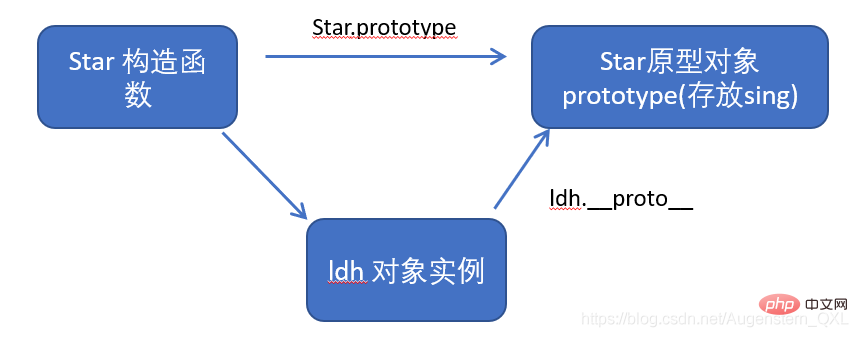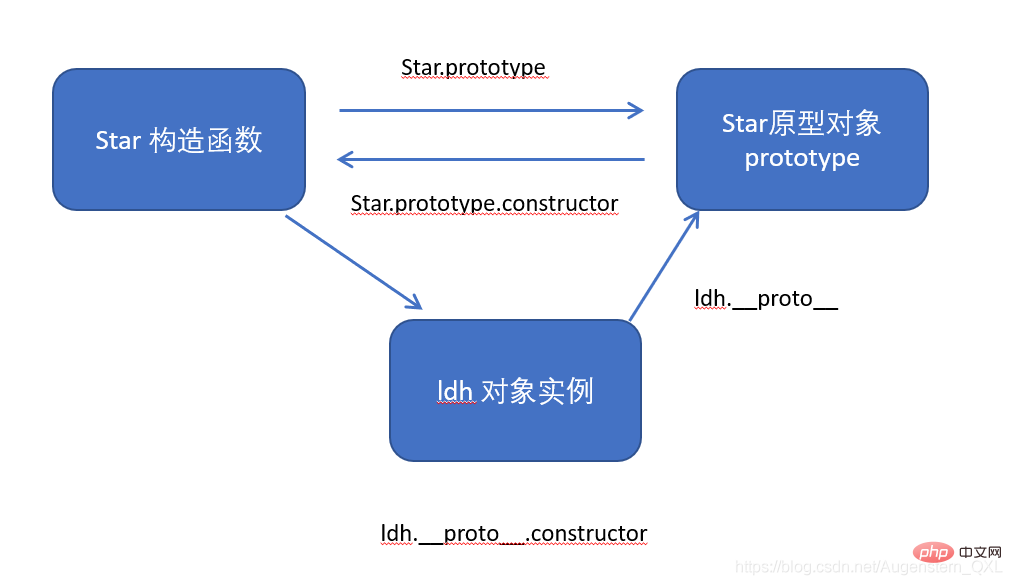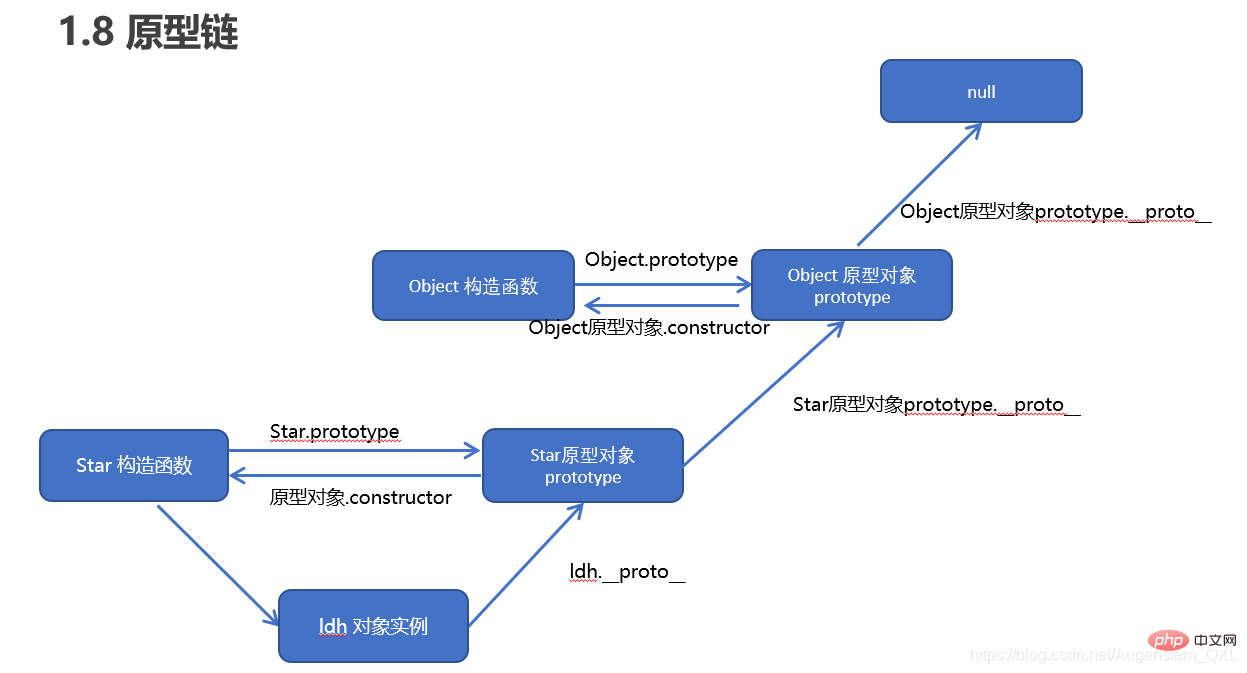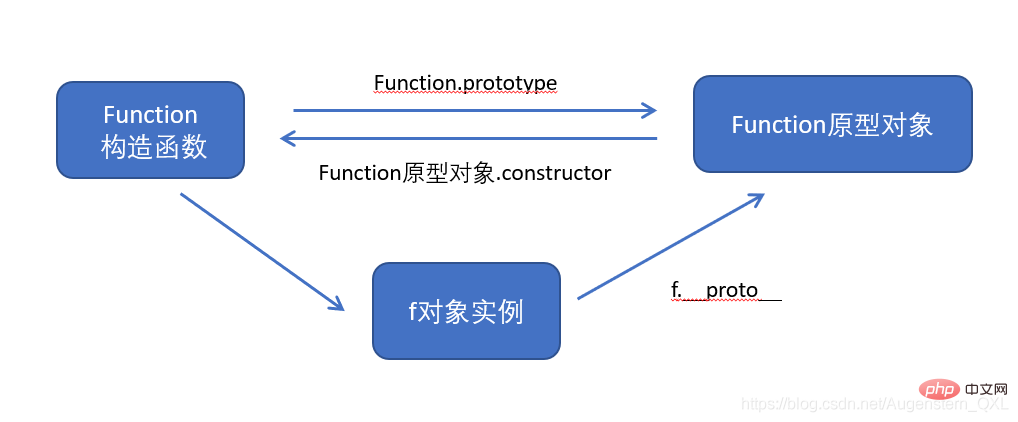爆肝整理JavaScript之物件導向(總結分享)

1、物件導向
物件導向更貼近我們的實際生活, 可以使用物件導向描述現實世界事物. 但是事物分為具體的事物和抽象的事物
物件導向的思維特點:
- 抽取(抽象)物件共用的屬性和行為組織(封裝)成一個類(模板)
- 對類進行範例化, 獲取類的物件
1.1、物件
在 JavaScript 中,物件是一組無序的相關屬性和方法的集合,所有的事物都是物件,例如字串、數值、陣列、函數等。
物件是由屬性和方法組成的
- 屬性:事物的特徵,在物件中用屬性來表示
- 方法:事物的行為,在物件中用方法來表示
1.2、類
在 ES6 中新增加了類的概念,可以使用 class 關鍵字宣告一個類,之後以這個類來範例化物件。
- 類抽象了物件的公共部分,它泛指某一大類(class)
- 物件特指某一個,通過類範例化一個具體的物件
1.2.1、建立類
class name {
// class body}- 建立範例
var XX = new name();
注意:類必須使用new 範例化物件
1.2.2、建構函式
constructor()方法是類別建構函式(預設方法),用於傳遞引數,返回範例物件,通過 new 命令生成物件範例時,自動呼叫該方法。如果沒有顯示定義, 類內部會自動給我們建立一個constructor()
<script>
// 1. 建立類 class 建立一個 明星類
class Star {
// constructor 構造器或者建構函式
constructor(uname, age) {
this.uname = uname;
this.age = age;
}
}
// 2. 利用類建立物件 new
var ldh = new Star('劉德華', 18);
var zxy = new Star('張學友', 20);
console.log(ldh);
console.log(zxy);</script>- 通過 class 關鍵字建立類,類名我們還是習慣性定義首字母大寫
- 類裡面有個
constructor函數,可以接收傳遞過來的引數,同時返回範例物件 constructor函數只要 new 生成範例時,就會自動呼叫這個函數,如果我們不寫這個函數,類也會自動生成這個函數- 最後注意語法規範
- 建立類➡類名後面不要加小括號
- 生成範例➡類名後面加小括號
- 建構函式不需要加 function 關鍵字
1.2.3、類中新增方法
語法:
class Person {
constructor(name,age) {
// constructor 稱為構造器或者建構函式
this.name = name;
this.age = age;
}
say() {
console.log(this.name + '你好');
}} var ldh = new Person('劉德華', 18); ldh.say()注意: 方法之間不能加逗號分隔,同時方法不需要新增 function 關鍵字。
<script>
// 1. 建立類 class 建立一個 明星類
class Star {
// 類的共有屬性放到 constructor 裡面
constructor(uname, age) {
this.uname = uname;
this.age = age;
}
sing(song) {
console.log(this.uname + song);
}
}
// 2. 利用類建立物件 new
var ldh = new Star('劉德華', 18);
var zxy = new Star('張學友', 20);
console.log(ldh);
console.log(zxy);
// (1) 我們類裡面所有的函數不需要寫function
// (2) 多個函數方法之間不需要新增逗號分隔
ldh.sing('冰雨');
zxy.sing('李香蘭');</script>- 類的共有屬性放到
constructor裡面 - 類裡面的函數都不需要寫
function關鍵字
1.3 、類的繼承
現實中的繼承:子承父業,比如我們都繼承了父親的姓。
程式中的繼承:子類可以繼承父類別的一些屬性和方法。
語法:
// 父類別class Father {
}// 子類繼承父類別class Son extends Father {
}看一個範例:
<script>
// 父類別有加法方法
class Father {
constructor(x, y) {
this.x = x;
this.y = y;
}
sum() {
console.log(this.x + this.y);
}
}
// 子類繼承父類別加法方法 同時 擴充套件減法方法
class Son extends Father {
constructor(x, y) {
// 利用super 呼叫父類別的建構函式
// super 必須在子類this之前呼叫
super(x, y);
this.x = x;
this.y = y;
}
subtract() {
console.log(this.x - this.y);
}
}
var son = new Son(5, 3);
son.subtract();
son.sum();</script>1.4、super關鍵字
super關鍵字用於存取和呼叫物件父類別上的函數,可以呼叫父類別的建構函式,也可以呼叫父類別的普通函數
1.4.1、呼叫父類別的建構函式
語法:
// 父類別class Person {
constructor(surname){
this.surname = surname;
}}// 子類繼承父類別class Student entends Person {
constructor(surname,firstname) {
super(surname); //呼叫父類別的 constructor(surname)
this.firstname = firstname; //定義子類獨有的屬性
}}注意:子類在建構函式中使用super,必須放到this前面(必須先呼叫父類別的構造方法,在使用子類構造方法)
案例:
// 父類別class Father {
constructor(surname){
this.surname = surname;
}
saySurname() {
console.log('我的姓是' + this.surname);
}}// 子類繼承父類別class Son entends Father {
constructor(surname,firstname) {
super(surname); //呼叫父類別的 constructor(surname)
this.firstname = firstname; //定義子類獨有的屬性
}
sayFirstname() {
console.log('我的名字是:' + this.firstname);
}}var damao = new Son('劉','德華');damao.saySurname();damao.sayFirstname();1.4.2、呼叫父類別的普通函數
語法:
class Father {
say() {
return '我是爸爸';
}}class Son extends Father {
say(){
// super.say() super呼叫父類別的方法
return super.say() + '的兒子';
}}var damao = new Son();console.log(damao.say());多個方法之間不需要新增逗號分隔
繼承中屬性和方法的查詢原則:就近原則,先看子類,再看父類別
1.4、三個注意點
- 在ES6中類沒有變數提升,所以必須先定義類,才能通過類範例化物件
- 類裡面的共有屬性和方法一定要加
this使用 - 類裡面的
this指向:- constructor 裡面的
this指向範例物件 - 方法裡面的
this指向這個方法的呼叫者
- constructor 裡面的
<body>
<button>點選</button>
<script>
var that;
var _that;
class Star {
constructor(uname, age) {
// constructor 裡面的this 指向的是 建立的範例物件
that = this;
this.uname = uname;
this.age = age;
// this.sing();
this.btn = document.querySelector('button');
this.btn.onclick = this.sing;
}
sing() {
// 這個sing方法裡面的this 指向的是 btn 這個按鈕,因為這個按鈕呼叫了這個函數
console.log(that.uname);
// that裡面儲存的是constructor裡面的this
}
dance() {
// 這個dance裡面的this 指向的是範例物件 ldh 因為ldh 呼叫了這個函數
_that = this;
console.log(this);
}
}
var ldh = new Star('劉德華');
console.log(that === ldh);
ldh.dance();
console.log(_that === ldh);
// 1. 在 ES6 中類沒有變數提升,所以必須先定義類,才能通過類範例化物件
// 2. 類裡面的共有的屬性和方法一定要加this使用.
</script></body>2、建構函式和原型
2.1、概述
在典型的 OOP 的語言中(如 Java),都存在類的概念,類就是物件的模板,物件就是類的範例,但在 ES6之前, JS 中並沒用引入類的概念。
ES6, 全稱 ECMAScript 6.0 ,2015.06 發版。但是目前瀏覽器的 JavaScript 是 ES5 版本,大多數高版本的瀏覽器也支援 ES6,不過只實現了 ES6 的部分特性和功能。
在 ES6之前 ,物件不是基於類建立的,而是用一種稱為構建函數的特殊函數來定義物件和它們的特徵。
- 建立物件有三種方式
- 物件字面量
- new Object()
- 自定義建構函式
// 1. 利用 new Object() 建立物件var obj1 = new Object();// 2. 利用物件字面量建立物件var obj2 = {};// 3.利用建構函式建立物件function Star(uname,age) {
this.uname = uname;
this.age = age;
this.sing = function() {
console.log('我會唱歌');
}}var ldh = new Star('劉德華',18);注意:
- 建構函式用於建立某一類物件,其首字母要大寫
- 建構函式要和
new一起使用才有意義
2.2、建構函式
- 建構函式是一種特殊的函數,主要用來初始化物件(為物件成員變數賦初始值),它總與
new一起使用 - 我們可以把物件中的一些公共的屬性和方法抽取出來,然後封裝到這個函數裡面
new 在執行時會做四件事
- 在記憶體中建立一個新的空物件。
- 讓 this 指向這個新的物件。
- 執行建構函式裡面的程式碼,給這個新物件新增屬性和方法。
- 返回這個新物件(所以建構函式裡面不需要 return )。
2.2.1、靜態成員和範例成員
JavaScript 的建構函式中可以新增一些成員,可以在建構函式本身上新增,也可以在建構函式內部的this上新增。通過這兩種方式新增的成員,就分別稱為靜態成員和範例成員。
- 靜態成員:在建構函式本身上新增的成員為靜態成員,只能由建構函式本身來存取
- 範例成員:在建構函式內部建立的物件成員稱為範例成員,只能由範例化的物件來存取
// 建構函式中的屬性和方法我們稱為成員,成員可以新增
function Star(uname,age) {
this.uname = uname;
this.age = age;
this.sing = function() {
console.log('我會唱歌');
}
}
var ldh = new Star('劉德華',18);
// 範例成員就是建構函式內部通過this新增的成員 uname age sing 就是範例成員
// 範例成員只能通過範例化的物件來存取
ldh.sing();
Star.uname; // undefined 不可以通過建構函式來存取範例成員
// 靜態成員就是在建構函式本身上新增的成員 sex 就是靜態成員
// 靜態成員只能通過建構函式來存取
Star.sex = '男';
Star.sex;
ldh.sex; // undefined 不能通過物件來存取2.2.2、建構函式的問題
建構函式方法很好用,但是存在浪費記憶體的問題。

- 我們希望所有的物件使用同一個函數,這樣就比較節省記憶體
2.3、建構函式原型 prototype
- 建構函式通過原型分配的函數是所有物件所共用的,這樣就解決了記憶體浪費問題
- JavaScript 規定,每一個建構函式都有一個
prototype屬性,指向另一個物件,注意這個prototype就是一個物件,這個物件的所有屬性和方法,都會被建構函式所擁有 - 我們可以把那些不變的方法,直接定義在
prototype物件上,這樣所有物件的範例就可以共用這些方法
<body>
<script>
// 1. 建構函式的問題.
function Star(uname, age) {
//公共屬性定義到建構函式裡面
this.uname = uname;
this.age = age;
// this.sing = function() {
// console.log('我會唱歌');
// }
}
//公共的方法我們放到原型物件身上
Star.prototype.sing = function() {
console.log('我會唱歌');
}
var ldh = new Star('劉德華', 18);
var zxy = new Star('張學友', 19);
console.log(ldh.sing === zxy.sing);
ldh.sing();
zxy.sing();
// 2. 一般情況下,我們的公共屬性定義到建構函式裡面, 公共的方法我們放到原型物件身上
</script></body>- 一般情況下,我們的公共屬性定義到建構函式裡面, 公共的方法我們放到原型物件身上
問答:原型是什麼?
- 一個物件,我們也稱為
prototype為原型物件
問答:原型的作用是什麼?
- 共用方法
2.4、物件原型 __ proto __
- 物件都會有一個屬性
_proto_指向建構函式的prototype原型物件,之所以我們物件可以使用建構函式prototype原型物件的屬性和方法,就是因為物件有_proto_原型的存在。 _proto_物件原型和原型物件prototype是等價的_proto_物件原型的意義就在於為物件的查詢機制提供一個方向,或者說一條路線,但是它是一個非標準屬性,因此實際開發中,不可以使用這個屬性,它只是內部指向原型物件prototype

Star.prototype 和 ldh._proto_指向相同
<body>
<script>
function Star(uname, age) {
this.uname = uname;
this.age = age;
}
Star.prototype.sing = function() {
console.log('我會唱歌');
}
var ldh = new Star('劉德華', 18);
var zxy = new Star('張學友', 19);
ldh.sing();
console.log(ldh);
// 物件身上系統自己新增一個 __proto__ 指向我們建構函式的原型物件 prototype
console.log(ldh.__proto__ === Star.prototype);
// 方法的查詢規則: 首先先看ldh 物件身上是否有 sing 方法,如果有就執行這個物件上的sing
// 如果沒有sing 這個方法,因為有 __proto__ 的存在,就去建構函式原型物件prototype身上去查詢sing這個方法
</script></body>2.5、constructor 建構函式
物件原型(__ proto __)和建構函式(prototype)原型物件裡面都有一個屬性constructor屬性, constructor 我們稱為建構函式,因為它指回建構函式本身。
constructor主要用於記錄該物件參照於哪個建構函式,它可以讓原型物件重新指向原來的建構函式一般情況下,物件的方法都在建構函式(prototype)的原型物件中設定
如果有多個物件的方法,我們可以給原型物件
prototype採取物件形式賦值,但是這樣會覆蓋建構函式原型物件原來的內容,這樣修改後的原型物件constructor就不再指向當前建構函式了。此時,我們可以在修改後的原型物件中,新增一個constructor指向原來的建構函式
具體請看範例配合理解
<body>
<script>
function Star(uname, age) {
this.uname = uname;
this.age = age;
}
// 很多情況下,我們需要手動的利用constructor 這個屬性指回 原來的建構函式
// Star.prototype.sing = function() {
// console.log('我會唱歌');
// };
// Star.prototype.movie = function() {
// console.log('我會演電影');
// }
Star.prototype = {
// 如果我們修改了原來的原型物件,給原型物件賦值的是一個物件,則必須手動的利用constructor指回原來的建構函式
constructor: Star,
sing: function() {
console.log('我會唱歌');
},
movie: function() {
console.log('我會演電影');
}
}
var ldh = new Star('劉德華', 18);
var zxy = new Star('張學友', 19);
</script></body>2.6、建構函式、範例、原型物件三者關係

2.7、原型鏈查詢規則
- 當存取一個物件的屬性(包括方法)時,首先查詢這個物件自身有沒有該屬性
- 如果沒有就查詢它的原型(也就是
_proto_指向的prototype原型物件) - 如果還沒有就查詢原型物件的原型(Object的原型物件)
- 依次類推一直找到Object為止(null)
- __ proto __物件原型的意義就在於為物件成員查詢機制提供一個方向,或者說一條路線。

<body>
<script>
function Star(uname, age) {
this.uname = uname;
this.age = age;
}
Star.prototype.sing = function() {
console.log('我會唱歌');
}
var ldh = new Star('劉德華', 18);
// 1. 只要是物件就有__proto__ 原型, 指向原型物件
console.log(Star.prototype);
console.log(Star.prototype.__proto__ === Object.prototype);
// 2.我們Star原型物件裡面的__proto__原型指向的是 Object.prototype
console.log(Object.prototype.__proto__);
// 3. 我們Object.prototype原型物件裡面的__proto__原型 指向為 null
</script></body>2.8、原型物件this指向
- 建構函式中的
this指向我們的範例物件 - 原型物件裡面放的是方法,這個方法裡面的
this指向的是這個方法的呼叫者,也就是這個範例物件
<body>
<script>
function Star(uname, age) {
this.uname = uname;
this.age = age;
}
var that;
Star.prototype.sing = function() {
console.log('我會唱歌');
that = this;
}
var ldh = new Star('劉德華', 18);
// 1. 在建構函式中,裡面this指向的是物件範例 ldh
ldh.sing();
console.log(that === ldh);
// 2.原型物件函數裡面的this 指向的是 範例物件 ldh
</script></body>2.9、擴充套件內建物件
- 可以通過原型物件,對原來的內建物件進行擴充套件自定義的方法
- 比如給陣列增加自定義求偶數和的功能
<body>
<script>
// 原型物件的應用 擴充套件內建物件方法
Array.prototype.sum = function() {
var sum = 0;
for (var i = 0; i < this.length; i++) {
sum += this[i];
}
return sum;
};
// Array.prototype = {
// sum: function() {
// var sum = 0;
// for (var i = 0; i < this.length; i++) {
// sum += this[i];
// }
// return sum;
// }
// }
var arr = [1, 2, 3];
console.log(arr.sum());
console.log(Array.prototype);
var arr1 = new Array(11, 22, 33);
console.log(arr1.sum());
</script></body>注意:
- 陣列和字串內建物件不能給原型物件覆蓋操作
Array.prototype = {},只能是Array.prototype.xxx = function(){}的方式
3、繼承
ES6 之前並沒有給我們提供extends繼承
- 我們可以通過建構函式+原型物件模擬實現繼承,被稱為組合繼承
3.1、call()
呼叫這個函數,並且修改函數執行時的 this 指向
fun.call(thisArg,arg1,arg2,......)
thisArg:當前呼叫函數 this 的指向物件arg1,arg2: 傳遞的其他引數
範例
<body>
<script>
// call 方法
function fn(x, y) {
console.log('我希望我的希望有希望');
console.log(this); // Object{...}
console.log(x + y); // 3
}
var o = {
name: 'andy'
};
// fn();
// 1. call() 可以呼叫函數
// fn.call();
// 2. call() 可以改變這個函數的this指向 此時這個函數的this 就指向了o這個物件
fn.call(o, 1, 2);
</script></body>3.2、借用建構函式繼承父類別型屬性
- 核心原理: 通過
call()把父類別型的 this 指向子型別的 this,這樣就可以實現子型別繼承父類別型的屬性
<body>
<script>
// 借用父建構函式繼承屬性
// 1. 父建構函式
function Father(uname, age) {
// this 指向父建構函式的物件範例
this.uname = uname;
this.age = age;
}
// 2 .子建構函式
function Son(uname, age, score) {
// this 指向子建構函式的物件範例
Father.call(this, uname, age);
this.score = score;
}
var son = new Son('劉德華', 18, 100);
console.log(son);
</script></body>3.3、借用原型物件繼承父類別型方法
- 一般情況下,物件的方法都在建構函式的原型物件中設定,通過建構函式無法繼承父類別方法
核心原理:
- 將子類所共用的方法提取出來,讓子類的
prototype 原型物件 = new 父類別() - 本質: 子類原型物件等於是範例化父類別,因為父類別範例化之後另外開闢空間,就不會影響原來父類別原型物件
- 將子類的
constructor重新指向子類別建構函式
<body>
<script>
// 借用父建構函式繼承屬性
// 1. 父建構函式
function Father(uname, age) {
// this 指向父建構函式的物件範例
this.uname = uname;
this.age = age;
}
Father.prototype.money = function() {
console.log(100000);
};
// 2 .子建構函式
function Son(uname, age, score) {
// this 指向子建構函式的物件範例
Father.call(this, uname, age);
this.score = score;
}
// Son.prototype = Father.prototype; 這樣直接賦值會有問題,如果修改了子原型物件,父原型物件也會跟著一起變化
Son.prototype = new Father();
// 如果利用物件的形式修改了原型物件,別忘了利用constructor 指回原來的建構函式
Son.prototype.constructor = Son;
// 這個是子建構函式專門的方法
Son.prototype.exam = function() {
console.log('孩子要考試');
}
var son = new Son('劉德華', 18, 100);
console.log(son);
console.log(Father.prototype);
console.log(Son.prototype.constructor);
</script></body>3.3 類的本質
- class 本質還是 function
- 類的所有方法都定義在類的
prototype屬性上 - 類建立的範例,裡面也有
_proto_指向類的prototype原型物件 - 所以 ES6 的類它的絕大部分功能,ES5都可以做到,新的class寫法只是讓物件原型的寫法更加清晰、更像物件導向程式設計的語法而已。
- 所以 ES6 的類其實就是語法糖
- 語法糖:語法糖就是一種便捷寫法,簡單理解
4、ES5新增方法
ES5 給我們新增了一些方法,可以很方便的運算元組或者字串
- 陣列方法
- 字串方法
- 物件方法
4.1、陣列方法
- 迭代(遍歷)方法:foreach() ,map(),filter(),some() ,every() ;
4.1.1、forEach()
array.forEach(function(currentValue,index,arr))
- currentValue: 陣列當前項的值
- index: 陣列當前項的索引
- arr: 陣列物件本身
<body>
<script>
// forEach 迭代(遍歷) 陣列
var arr = [1, 2, 3];
var sum = 0;
arr.forEach(function(value, index, array) {
console.log('每個陣列元素' + value);
console.log('每個陣列元素的索引號' + index);
console.log('陣列本身' + array);
sum += value;
})
console.log(sum);
</script></body>4.1.2、filter()篩選陣列
array.filter(function(currentValue,index,arr))
filter()方法建立一個新的陣列,新陣列中的元素是通過檢查指定陣列中符合條件的所有元素,主要用於篩選陣列- 注意它直接返回一個新陣列
<body>
<script>
// filter 篩選陣列
var arr = [12, 66, 4, 88, 3, 7];
var newArr = arr.filter(function(value, index) {
// return value >= 20;
return value % 2 === 0;
});
console.log(newArr);
</script></body>4.1.3、some()
some()方法用於檢測陣列中的元素是否滿足指定條件(查詢陣列中是否有滿足條件的元素)- 注意它返回的是布林值,如果查詢到這個元素,就返回true,如果查詢不到就返回false
- 如果找到第一個滿足條件的元素,則終止迴圈,不再繼續查詢
<body>
<script>
// some 查詢陣列中是否有滿足條件的元素
var arr1 = ['red', 'pink', 'blue'];
var flag1 = arr1.some(function(value) {
return value == 'pink';
});
console.log(flag1);
// 1. filter 也是查詢滿足條件的元素 返回的是一個陣列 而且是把所有滿足條件的元素返回回來
// 2. some 也是查詢滿足條件的元素是否存在 返回的是一個布林值 如果查詢到第一個滿足條件的元素就終止迴圈
</script></body>4.2、字串方法
trim()方法會從一個字串的兩端刪除空白字元trim()方法並不影響原字串本身,它返回的是一個新的字串
<body>
<input type="text"> <button>點選</button>
<p></p>
<script>
// trim 方法去除字串兩側空格
var str = ' an dy ';
console.log(str);
var str1 = str.trim();
console.log(str1);
var input = document.querySelector('input');
var btn = document.querySelector('button');
var p = document.querySelector('p');
btn.onclick = function() {
var str = input.value.trim();
if (str === '') {
alert('請輸入內容');
} else {
console.log(str);
console.log(str.length);
p.innerHTML = str;
}
}
</script></body>4.3、物件方法
4.3.1、Object.keys()
Object.keys()用於獲取物件自身所有的屬性- 效果類似
for...in - 返回一個由屬性名組成的陣列
<body>
<script>
// 用於獲取物件自身所有的屬性
var obj = {
id: 1,
pname: '小米',
price: 1999,
num: 2000
};
var arr = Object.keys(obj);
console.log(arr);
arr.forEach(function(value) {
console.log(value);
// id
// pname
// price
// num
})
</script></body>4.3.2、Object.defineProperty()
Object.defineProperty()定義物件中新屬性或修改原有的屬性(瞭解)
Object.defineProperty(obj,prop,descriptor)
- obj : 目標物件
- prop : 需定義或修改的屬性的名字
- descriptor : 目標屬性所擁有的特性
<body>
<script>
// Object.defineProperty() 定義新屬性或修改原有的屬性
var obj = {
id: 1,
pname: '小米',
price: 1999
};
// 1. 以前的物件新增和修改屬性的方式
// obj.num = 1000;
// obj.price = 99;
// console.log(obj);
// 2. Object.defineProperty() 定義新屬性或修改原有的屬性
Object.defineProperty(obj, 'num', {
value: 1000,
enumerable: true
});
console.log(obj);
Object.defineProperty(obj, 'price', {
value: 9.9
});
console.log(obj);
Object.defineProperty(obj, 'id', {
// 如果值為false 不允許修改這個屬性值 預設值也是false
writable: false,
});
obj.id = 2;
console.log(obj);
Object.defineProperty(obj, 'address', {
value: '中國山東藍翔技校xx單元',
// 如果只為false 不允許修改這個屬性值 預設值也是false
writable: false,
// enumerable 如果值為false 則不允許遍歷, 預設的值是 false
enumerable: false,
// configurable 如果為false 則不允許刪除這個屬性 不允許在修改第三個引數裡面的特性 預設為false
configurable: false
});
console.log(obj);
console.log(Object.keys(obj));
delete obj.address;
console.log(obj);
delete obj.pname;
console.log(obj);
Object.defineProperty(obj, 'address', {
value: '中國山東藍翔技校xx單元',
// 如果值為false 不允許修改這個屬性值 預設值也是false
writable: true,
// enumerable 如果值為false 則不允許遍歷, 預設的值是 false
enumerable: true,
// configurable 如果為false 則不允許刪除這個屬性 預設為false
configurable: true
});
console.log(obj.address);
</script></body>- 第三個引數 descriptor 說明:以物件形式{ }書寫
- value:設定屬性的值,預設為undefined
- writeable: 值是否可以重寫 true | false 預設為false
- enumerable: 目標屬性是否可以被列舉 true | false 預設為false
- configurable: 目標屬性是否可以被刪除或是否可以再次修改特性 true | false 預設為false
5、函數進階
5.1、函數的定義方式
- 函數宣告方式 function 關鍵字(命名函數)
- 函數表示式(匿名函數)
- new Function()
var fn = new Function('引數1','引數2',.....,'函數體');Function 裡面引數都必須是字串格式
第三種方式執行效率低,也不方便書寫,因此較少使用
所有函數都是 Function 的範例(物件)
函數也屬於物件

<body>
<script>
// 函數的定義方式
// 1. 自定義函數(命名函數)
function fn() {};
// 2. 函數表示式 (匿名函數)
var fun = function() {};
// 3. 利用 new Function('引數1','引數2', '函數體');
// Function 裡面引數都必須是字串格式,執行效率低,較少寫
var f = new Function('a', 'b', 'console.log(a + b)');
f(1, 2);
// 4. 所有函數都是 Function 的範例(物件)
console.dir(f);
// 5. 函數也屬於物件
console.log(f instanceof Object);
</script></body>5.2、函數的呼叫方式
- 普通函數
- 物件的方法
- 建構函式
- 繫結事件函數
- 定時器函數
- 立即執行函數
<body>
<script>
// 函數的呼叫方式
// 1. 普通函數
function fn() {
console.log('人生的巔峰');
}
// fn(); fn.call()
// 2. 物件的方法
var o = {
sayHi: function() {
console.log('人生的巔峰');
}
}
o.sayHi();
// 3. 建構函式
function Star() {};
new Star();
// 4. 繫結事件函數
// btn.onclick = function() {}; // 點選了按鈕就可以呼叫這個函數
// 5. 定時器函數
// setInterval(function() {}, 1000); 這個函數是定時器自動1秒鐘呼叫一次
// 6. 立即執行函數
(function() {
console.log('人生的巔峰');
})();
// 立即執行函數是自動呼叫
</script></body>5.3、函數內this的指向
this指向,是當我們呼叫函數的時候確定的,呼叫方式的不同決定了this的指向不同,一般我們指向我們的呼叫者
| 呼叫方式 | this指向 |
|---|---|
| 普通函數呼叫 | window |
| 建構函式呼叫 | 範例物件,原型物件裡面的方法也指向範例物件 |
| 物件方法呼叫 | 該方法所屬物件 |
| 事件繫結方法 | 繫結事件物件 |
| 定時器函數 | window |
| 立即執行函數 | window |
<body>
<button>點選</button>
<script>
// 函數的不同呼叫方式決定了this 的指向不同
// 1. 普通函數 this 指向window
function fn() {
console.log('普通函數的this' + this);
}
window.fn();
// 2. 物件的方法 this指向的是物件 o
var o = {
sayHi: function() {
console.log('物件方法的this:' + this);
}
}
o.sayHi();
// 3. 建構函式 this 指向 ldh 這個範例物件 原型物件裡面的this 指向的也是 ldh這個範例物件
function Star() {};
Star.prototype.sing = function() {
}
var ldh = new Star();
// 4. 繫結事件函數 this 指向的是函數的呼叫者 btn這個按鈕物件
var btn = document.querySelector('button');
btn.onclick = function() {
console.log('繫結時間函數的this:' + this);
};
// 5. 定時器函數 this 指向的也是window
window.setTimeout(function() {
console.log('定時器的this:' + this);
}, 1000);
// 6. 立即執行函數 this還是指向window
(function() {
console.log('立即執行函數的this' + this);
})();
</script></body>5.4、改變函數內部this指向
- JavaScript 為我們專門提供了一些函數方法來幫我們處理常式內部 this 的指向問題,常用的有
bind(),call(),apply()三種方法
5.4.1、call() 方法
call()方法呼叫一個物件,簡單理解為呼叫函數的方式,但是它可以改變函數的this指向fun.call(thisArg,arg1,arg2,.....)thisArg: 在 fun 函數執行時指定的 this 值arg1,arg2: 傳遞的其他引數- 返回值就是函數的返回值,因為它就是呼叫函數
- 因此當我們想改變 this 指向,同時想呼叫這個函數的時候,可以使用 call,比如繼承
<body>
<script>
// 改變函數內this指向 js提供了三種方法 call() apply() bind()
// 1. call()
var o = {
name: 'andy'
}
function fn(a, b) {
console.log(this);
console.log(a + b);
};
fn.call(o, 1, 2);
// call 第一個可以呼叫函數 第二個可以改變函數內的this 指向
// call 的主要作用可以實現繼承
function Father(uname, age, sex) {
this.uname = uname;
this.age = age;
this.sex = sex;
}
function Son(uname, age, sex) {
Father.call(this, uname, age, sex);
}
var son = new Son('劉德華', 18, '男');
console.log(son);
</script></body>5.4.2、apply()方法
apply()方法呼叫一個函數,簡單理解為呼叫函數的方式,但是它可以改變函數的this指向fun.apply(thisArg,[argsArray])- thisArg: 在 fun 函數執行時指定的 this 值
- argsArray : 傳遞的值,必須包含在陣列裡面
- 返回值就是函數的返回值,因為它就是呼叫函數
- 因此 apply 主要跟陣列有關係,比如使用 Math.max() 求陣列的最大值
<body>
<script>
// 改變函數內this指向 js提供了三種方法 call() apply() bind()
// 2. apply() 應用 運用的意思
var o = {
name: 'andy'
};
function fn(arr) {
console.log(this);
console.log(arr); // 'pink'
};
fn.apply(o, ['pink']);
// 1. 也是呼叫函數 第二個可以改變函數內部的this指向
// 2. 但是他的引數必須是陣列(偽陣列)
// 3. apply 的主要應用 比如說我們可以利用 apply 藉助於數學內建物件求陣列最大值
// Math.max();
var arr = [1, 66, 3, 99, 4];
var arr1 = ['red', 'pink'];
// var max = Math.max.apply(null, arr);
var max = Math.max.apply(Math, arr);
var min = Math.min.apply(Math, arr);
console.log(max, min);
</script></body>5.4.3、bind()方法
bind()方法不會呼叫函數。但是能改變函數內部this指向fun.bind(thisArg,arg1,arg2,....)- 返回由指定的
this值和初始化引數改造的原函數拷貝 - 因此當我們只是想改變 this 指向,並且不想呼叫這個函數的時候,可以使用bind
<body>
<button>點選</button>
<button>點選</button>
<button>點選</button>
<script>
// 改變函數內this指向 js提供了三種方法 call() apply() bind()
// 3. bind() 繫結 捆綁的意思
var o = {
name: 'andy'
};
function fn(a, b) {
console.log(this);
console.log(a + b);
};
var f = fn.bind(o, 1, 2);
f();
// 1. 不會呼叫原來的函數 可以改變原來函數內部的this 指向
// 2. 返回的是原函數改變this之後產生的新函數
// 3. 如果有的函數我們不需要立即呼叫,但是又想改變這個函數內部的this指向此時用bind
// 4. 我們有一個按鈕,當我們點選了之後,就禁用這個按鈕,3秒鐘之後開啟這個按鈕
// var btn1 = document.querySelector('button');
// btn1.onclick = function() {
// this.disabled = true; // 這個this 指向的是 btn 這個按鈕
// // var that = this;
// setTimeout(function() {
// // that.disabled = false; // 定時器函數裡面的this 指向的是window
// this.disabled = false; // 此時定時器函數裡面的this 指向的是btn
// }.bind(this), 3000); // 這個this 指向的是btn 這個物件
// }
var btns = document.querySelectorAll('button');
for (var i = 0; i < btns.length; i++) {
btns[i].onclick = function() {
this.disabled = true;
setTimeout(function() {
this.disabled = false;
}.bind(this), 2000);
}
}
</script></body>5.4.4、總結
call apply bind 總結:
相同點:
- 都可以改變函數內部的
this指向
區別點:
call和apply會呼叫函數,並且改變函數內部的this指向call和apply傳遞的引數不一樣,call 傳遞引數,apply 必須陣列形式bind不會呼叫函數,可以改變函數內部this指向
主要應用場景
call經常做繼承apply經常跟陣列有關係,比如藉助於數學對線實現陣列最大值與最小值bind不呼叫函數,但是還想改變this指向,比如改變定時器內部的this指向
相關推薦:
以上就是爆肝整理JavaScript之物件導向(總結分享)的詳細內容,更多請關注TW511.COM其它相關文章!